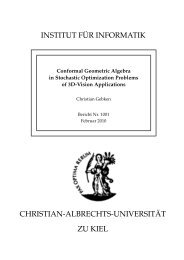Curry: An Integrated Functional Logic Language
Curry: An Integrated Functional Logic Language
Curry: An Integrated Functional Logic Language
Create successful ePaper yourself
Turn your PDF publications into a flip-book with our unique Google optimized e-Paper software.
since the variables occurring in parameters of the left-hand side are only visible in the corresponding<br />
conditions and right-hand sides. The visibility of other entities can be restricted using let in<br />
expressions or where in defining equations.<br />
<strong>An</strong> expression of the form let decls in exp introduces a set of local names. The list of local<br />
declarations decls can contain function definitions as well as definitions of constants by pattern<br />
matching. The names introduced in these declarations are visible in the expression exp and the<br />
right-hand sides of the declarations in decls, i.e., the local declarations can be mutually recursive.<br />
For instance, the expression<br />
let a=3*b<br />
b=6<br />
in 4*a<br />
reduces to the value 72.<br />
Auxiliary functions which are only introduced to define another function should often not be<br />
visible outside. Therefore, such functions can be declared in a where-clause added to the righthand<br />
side of the corresponding function definition. This is done in the following definition of a fast<br />
exponentiation where the auxiliary functions even and square are only visible in the right-hand<br />
side of the rule for exp:<br />
exp b n = if n==0<br />
then 1<br />
else if even n then square (exp b (n ‘div‘ 2))<br />
else b * (exp b (n-1))<br />
where even n = n ‘mod‘ 2 == 0<br />
square n = n*n<br />
Similarly to let, where-clauses can contain mutually recursive function definitions as well as definitions<br />
of constants by pattern matching. The names declared in the where-clauses are only visible<br />
in the corresponding conditions and right-hand sides. As a further example, the following <strong>Curry</strong><br />
program implements the quicksort algorithm with a function split which splits a list into two lists<br />
containing the smaller and larger elements:<br />
split e [] = ([],[])<br />
split e (x:xs) | e>=x = (x:l,r)<br />
| e
















